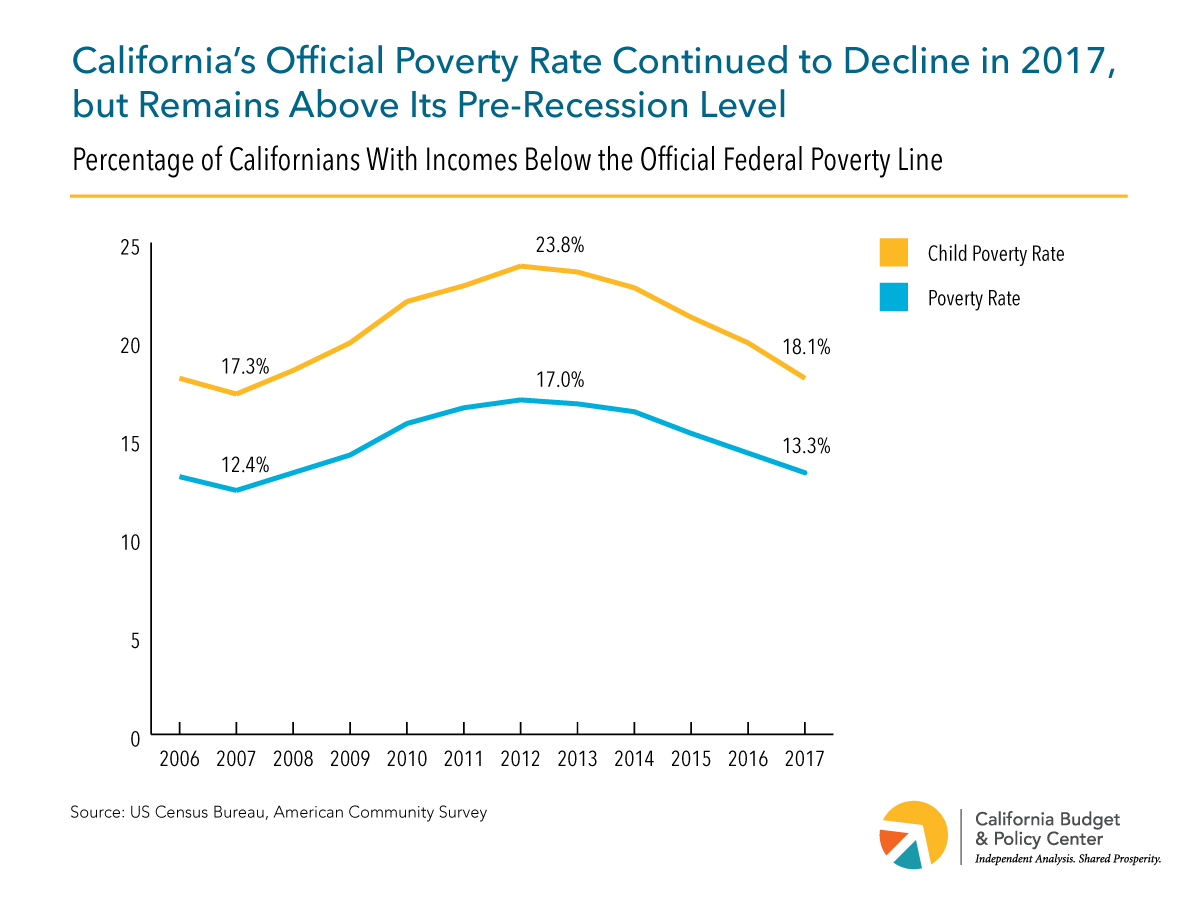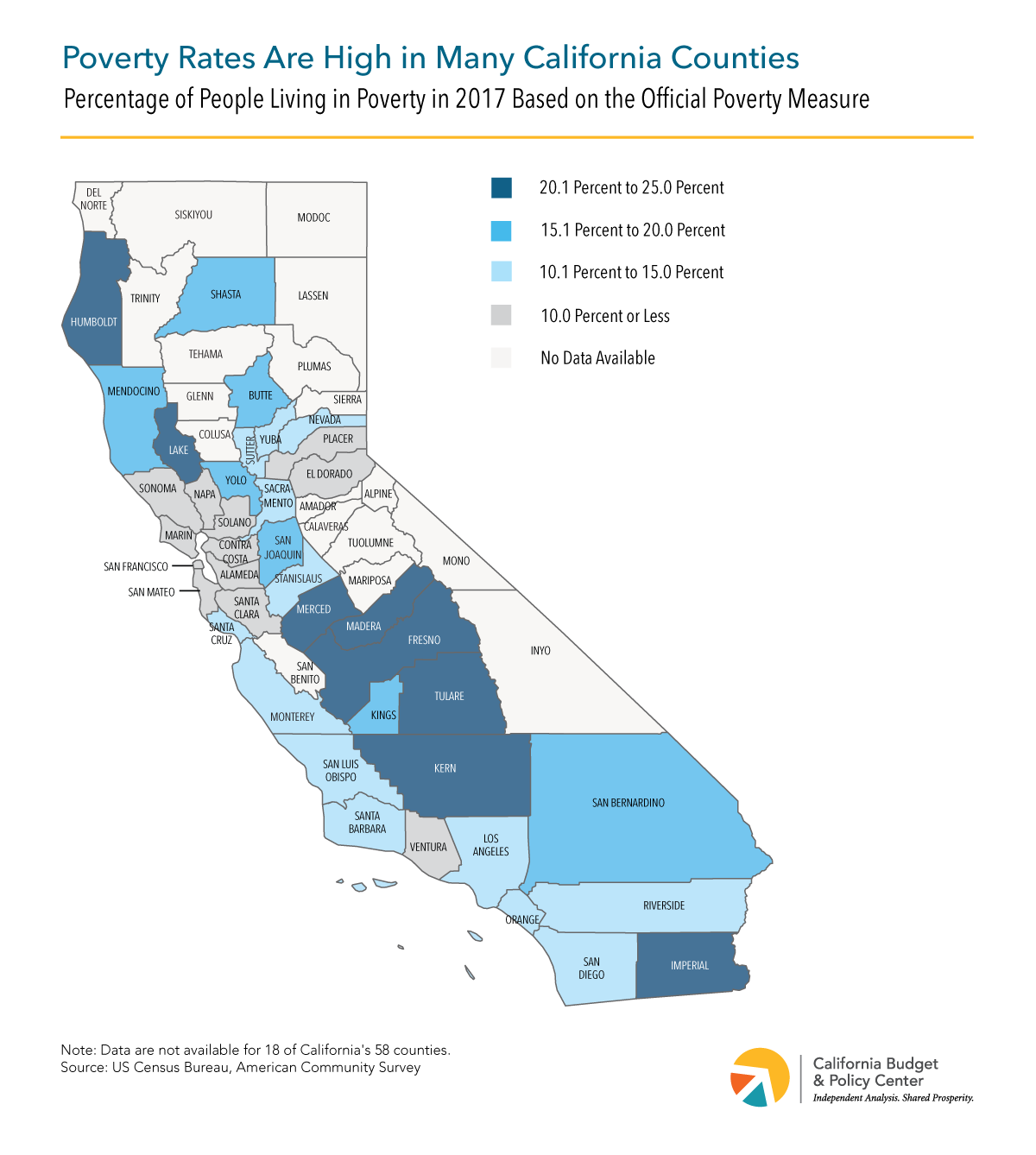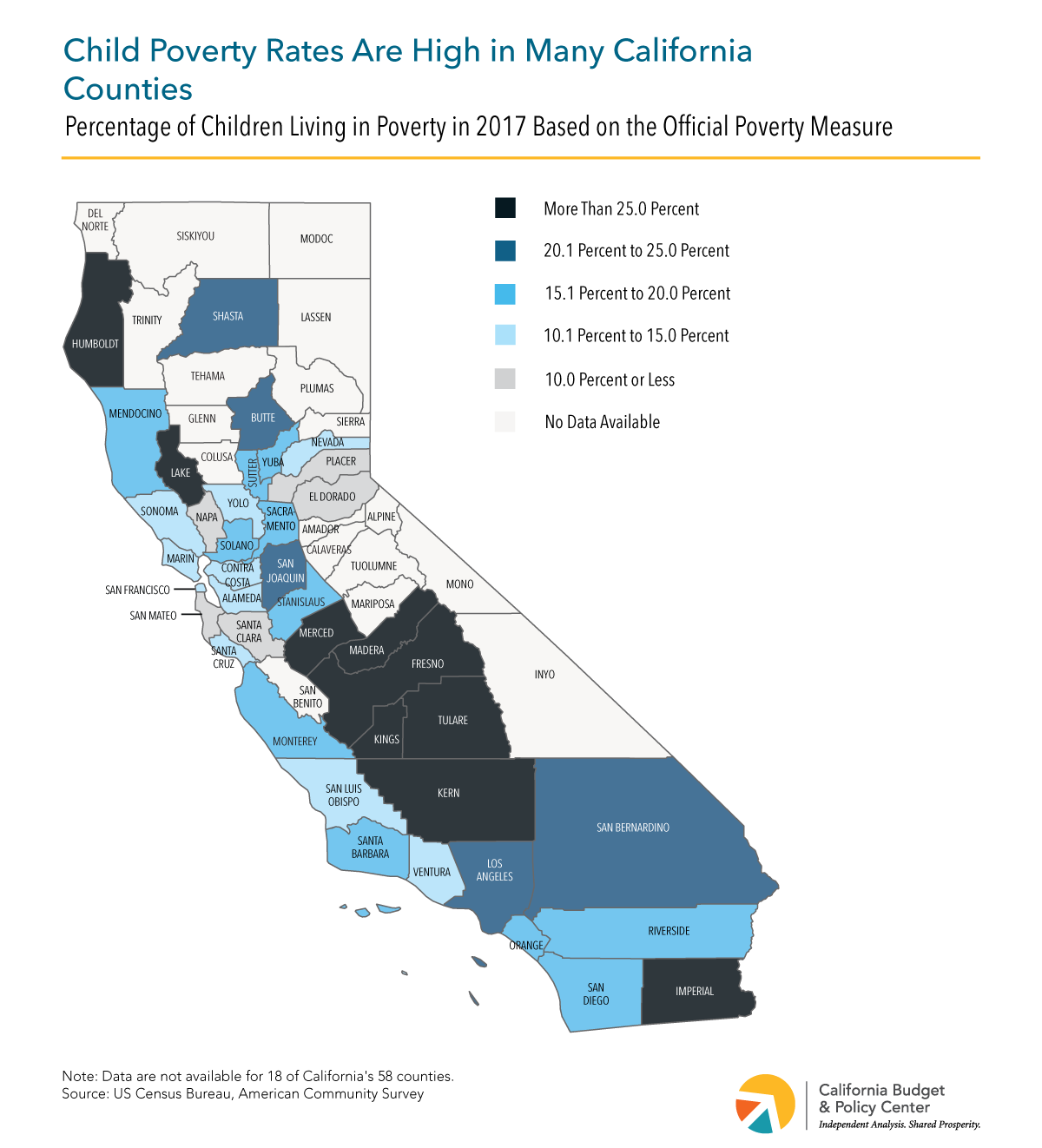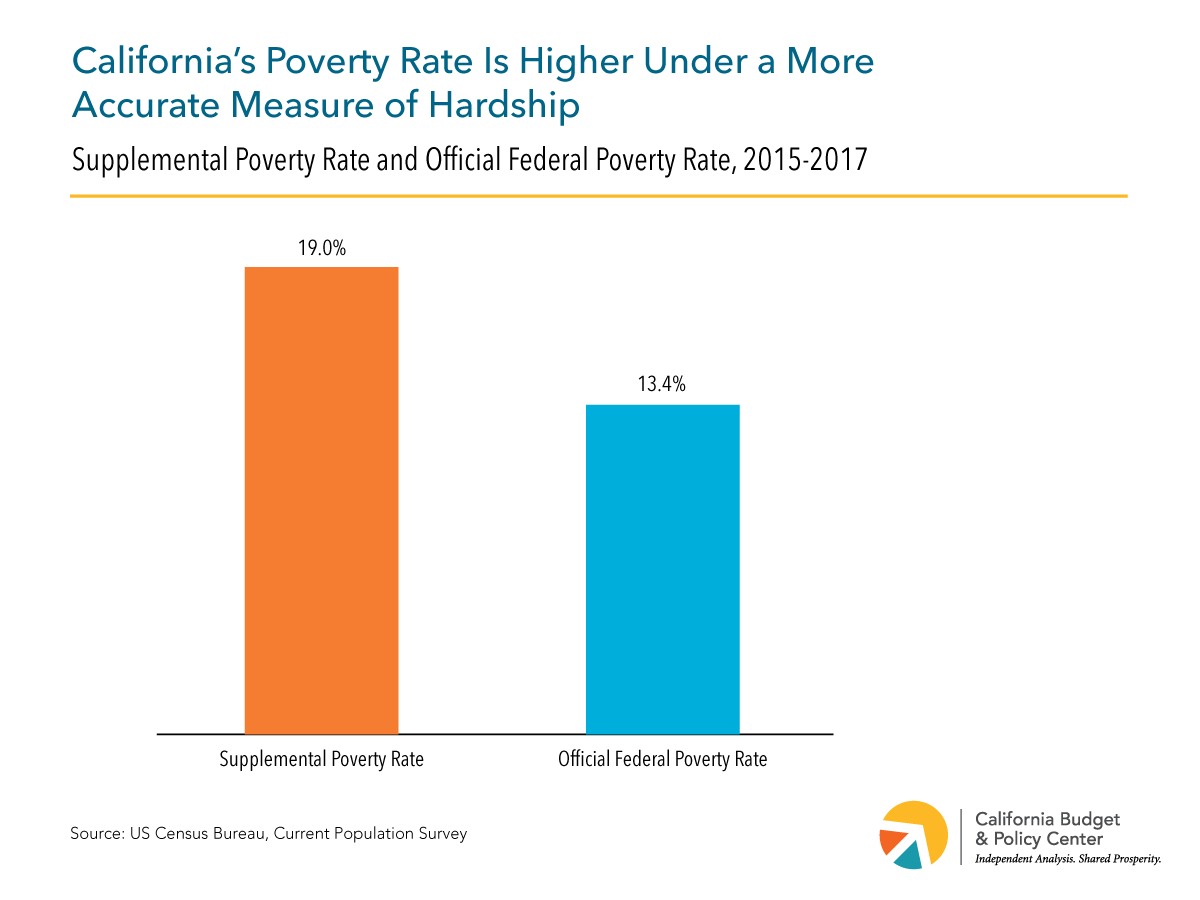Senior Policy Analyst Sara Kimberlin presented on policy options for addressing child poverty for the California Welfare Directors Association’s (CWDA) Directors Workshop.

December 2018 | By Sara Kimberlin
Download Full PresentationSenior Policy Analyst Sara Kimberlin presented on policy options for addressing child poverty for the California Welfare Directors Association’s (CWDA) Directors Workshop.
Join our email list!

New Census figures released today show promising gains in income and employment for Californians, yet also show that millions of California residents are still struggling to get by on extremely low incomes. These data underscore the need for policymakers to ensure that the economy’s recent gains are shared among all Californians.
The latest Census figures indicate that median household income in California grew to $71,805 in 2017, an increase of 3.8% over the prior year after adjusting for inflation. Median family income and median earnings for all workers also increased compared to inflation-adjusted income and earnings in 2016, and a larger share of Californians were employed. These positive economic gains are encouraging, but must be considered within the context of the slow speed overall with which the California economy has recovered from the Great Recession. Compared to 2007, when California incomes peaked before the Great Recession, median household income has only increased by 1.1% after adjusting for inflation. This modest real change in the incomes of typical households, this far into the economic recovery, helps explain why many Californians report that they do not feel economically secure, despite the state’s improving job market.
More troubling are new data from the Census that show that millions of people in California continue to struggle to get by on extremely low incomes. On the positive side, California’s official poverty rate of 13.3% for 2017 was lower compared to the previous year, when it was 14.3%. The state’s official child poverty rate also dropped to 18.1% in 2017, from a rate of 19.9% in 2016. However, 5.2 million Californians, including 1.6 million children, still lived in poverty in 2017 based on the official poverty measure. For a family of two adults and two children, for example, this means living on an annual cash income of less than about $24,900. Moreover, the state’s poverty rate and child poverty rate under the official poverty measure still have not dropped to their pre-Great Recession levels.

Also troubling, 2.2 million individuals, including 600,000 children, lived in deep poverty in 2017 based on the official poverty measure, meaning that their families had cash incomes of less than half of the official poverty threshold last year, or less than about $12,400 for a two-parent family with two children. The state’s deep poverty rates of 5.8% overall and 7.2% for children were lower than in 2016 (when they were 6.2% overall and 8.1% for children), but remain problematically high.
The latest Census figures also show that there are stark differences in people’s economic well-being across California’s counties. In 2017, the official poverty rate ranged from a low of 5.6% to a high of 24.6% across the counties, while the official child poverty rate ranged from 3.2% to 37.1%. In eight counties, more than 1 in 5 people lived in poverty, largely in the Central Valley (see Map 1). Additionally, more than 1 in 5 children lived in poverty in 14 counties, and this includes four counties — again, most in the Central Valley — where over 30% of children were in poverty (see Map 2).


Although these Census figures published today show that poverty remains unacceptably high in California, they actually understate the problem of economic hardship in the state because they reflect an outdated measure of poverty. Census figures released yesterday based on an improved measure — the Supplemental Poverty Measure (SPM), which accounts for the high cost of housing in many parts of the state — show that roughly 7.5 million Californians per year, nearly 1 in 5 state residents (19.0%), could not adequately support themselves and their families between 2015 and 2017. Under this more accurate measure of hardship, California continues to have one the highest poverty rates and by far the most residents in poverty of the 50 states.

The new Census poverty figures underscore the need for policymakers to do more to ensure that all people can share in our state’s economic progress. Some current state-level policy planning efforts, including the Lifting Children and Families Out of Poverty Task Force and the Assembly Blue Ribbon Commission on Early Childhood Education, represent important opportunities to prioritize investments that will help Californians avoid and overcome poverty and address the serious negative consequences of living in poverty.
Other specific steps that policymakers can take include:
Join our email list!

California continues to have one of the highest poverty rates among the 50 states, statistically tied for first with Florida and Louisiana, according to new Census data released this morning based on the Supplemental Poverty Measure (SPM). This poverty measure provides a more accurate indicator of economic need in California than the official federal poverty measure because it accounts for the high cost of living in many parts of the state, among other factors (see note below).
The new data show that about 7.5 million Californians — nearly 1 in 5 state residents (19.0%) — do not have enough resources to cover the costs of basic necessities. High housing costs are a key reason for California’s high SPM poverty rate, underscoring the need to increase access to affordable housing within the state. The new data also show the critical role played by public supports like tax credits, food assistance, and disability benefits in reducing poverty at the national level. Protecting and strengthening these supports is vital to bringing down California’s high poverty rate. State lawmakers have taken recent steps to bolster supports like the CalEITC, California’s refundable tax credit for working families, and CalWORKs, the state’s welfare-to-work program. National policymakers, on the other hand, over the past year have proposed changes to public supports that would reduce their effectiveness in addressing poverty, including changes currently being considered to the most important public source of food assistance.
With 7.5 million state residents struggling to get by, California has by far the largest number of individuals in poverty of any state, based on the SPM.[1] In fact, nearly 1 in 6 Americans in poverty live in California. The state’s high SPM poverty rate largely reflects the high housing costs in many parts of California. The SPM accounts for differences in housing costs across the country, unlike the official federal poverty measure, and when these costs are factored in, a much larger share of the state’s population is shown to be living in poverty: 19.0% under the SPM, compared to 13.4% under the official measure.[2] As a result, California’s poverty ranking among the 50 states jumps from 16th under the official poverty measure up to first under the SPM (statistically tied with Florida and Louisiana), a dubious distinction.[3]

Housing affordability is a problem throughout California, even in areas where housing costs are lower, because incomes are also lower in these areas. Statewide, more than half of renter households pay more than 30% of their incomes toward housing, making them housing cost-burdened, and nearly a third are severely cost-burdened, paying more than half of their incomes toward housing. California’s unaffordable housing costs are particularly a problem because they have been growing faster than incomes for most workers. While median household rents increased by 13.2% from 2006 to 2016, median annual earnings for full-time workers (those working at least 35 hours per week) grew by only 4.1% during that period.

Given California’s serious housing affordability challenges, it is important to pursue policies that can help increase the availability of affordable housing and meet the needs of individuals and families facing housing crises. This year state policymakers took several important steps to support local and statewide efforts to increase the availability of shelter and support services for Californians at risk of or struggling with homelessness. Building on these steps, voters will have the opportunity to consider several state ballot measures this fall that aim to address the state’s housing challenges (as will be discussed in upcoming Budget Center publications and blog posts).
With nearly 1 in 5 residents still struggling with poverty, even as the unemployment rate has dropped substantially since the Great Recession, Californians need strong support from state and national leaders to enable more people to share in the economy’s recent gains. Yet proposals by federal policymakers would change key public supports in ways that would reduce support for families and individuals struggling with poverty. Congress is currently considering a proposal to cut funding and impose new work requirements on people who receive food assistance through the Supplemental Nutrition Assistance Program (SNAP, known as CalFresh in California) as part of the Farm Bill that is expected to be passed this month. The Trump Administration is also soon expected to propose a new “public charge” rule for immigrants applying for green cards that would jeopardize their chances of long-term legal status if they or any of their family members (including US-born citizen children) use supports like public health insurance or receive benefits like refundable tax credits for low-income working families.
These proposed policy changes would result in fewer families and individuals accessing the public supports they need to meet critical basic needs, likely increasing California’s already unacceptably high poverty rate. Moreover, research shows that public investment in safety net supports for children, in particular, produces important long-term public and private benefits as a result of improvements in health and economic productivity in adulthood — an argument for strengthening, rather than shrinking, these types of investments.[4]
* * *
Note About the Census Bureau Data Released Today
The state-level figures released today reflect average annual poverty rates during a three-year period, from 2015 to 2017. The SPM addresses a number of shortcomings of the official poverty measure. One is the fact that under the official measure, the income threshold for determining who lives in poverty is the same in all parts of the US. For example, a single parent with two children was considered to be living in poverty in 2017 if their annual income was below about $19,700, regardless of whether they lived in a low-cost place like rural Mississippi or a high-cost place like San Francisco. The SPM better accounts for differences in the cost of living by adjusting the poverty threshold to reflect differences in the cost of housing throughout the US. For example, the SPM poverty line for a single parent with two children living in a renter household in San Francisco was about $30,800 in 2017 — considerably higher than the poverty line based on the official measure.
Another shortcoming of the official poverty measure is that it fails to factor in the broad array of resources that families use to pay for basic expenses. The official measure only counts cash income sources, such as earnings from work, Social Security payments, and cash assistance from welfare-to-work programs. It does not take into account noncash resources, such as food or housing assistance, and it fails to consider how tax benefits, such as the federal Earned Income Tax Credit (EITC), increase people’s economic well-being. The SPM improves on the official measure by including these resources. It also better accounts for the resources people actually have available to spend by subtracting from their incomes what is needed to pay for necessary expenses, including work-related expenses, such as child care; medical expenses, such as health insurance premiums and out-of-pocket costs; and state and federal income and payroll taxes.
After incorporating these improvements over the official poverty measure, the SPM produces a more realistic picture of poverty in California: the state’s SPM poverty rate was 1.4 times the official poverty rate between 2015 and 2017 (19.0% versus 13.4%, respectively).

Although the SPM provides a more accurate picture of economic hardship in California, it does not indicate how much people need to earn to achieve a basic standard of living. Measures of what it actually takes to make ends meet in California show that families need incomes several times higher than the official poverty line to afford basic necessities.
[1] Texas had the second-highest number of residents in SPM poverty at 4.1 million.
[2] The SPM poverty rate is also higher than the official poverty rate for most major demographic groups in California. See Alissa Anderson, A Better Measure of Poverty Shows How Widespread Economic Hardship Is in California (California Budget & Policy Center: October 2016).
[3] Florida had an annual average of 18.1% of state residents living in poverty based on the SPM from 2015 to 2017, while in Louisiana the poverty rate was 17.7%. The annual average SPM poverty rates for California, Florida, and Louisiana were not statistically different for this three year period, so all three states were statistically tied for the highest state SPM poverty rate.
[4] See Hilary Hoynes and Diane Schanzenbach, Safety Net Investments in Children (National Bureau of Economic Research: May 2018).
Join our email list!

Women’s participation in the California workforce has become critical to families’ financial security and the state’s economic well-being. As part of our work on the California Women’s Well-Being Index, the Budget Center recently released a set of issue briefs focusing on women’s employment, earnings, and economic security, highlighting how gender- and race-based discrimination continues to hold women back. Labor Day presents an opportunity to highlight the data and analysis from these new briefs and also to discuss policy solutions that could boost the financial security of women and their families in California.
The share of working women with children has nearly doubled in the past 50 years, and the most recent data show that 2 out of 3 women with children under the age of 18 are in the labor force. Because so many mothers are working for pay, over half (55%) made a significant contribution to their families’ finances in California in 2016 — more than double the share in 1967 (see chart below). Yet, despite the dramatic increase in mothers’ labor force participation, state and federal policies do not go far enough to support parents struggling to balance work and family obligations. This holds women, their families, and the economy back. The right policy choices are particularly important for parents with low incomes who often have limited benefits and are subject to unpredictable and nonstandard work schedules, making it difficult to both hold a job and care for their families.

Women are more likely overall than men to earn low wages, but a much larger share of Latinx women earned low wages compared to women in other racial and ethnic groups. In California in 2016, 55% of Latinx women earned low wages — defined as less than $14.71 per hour (see chart below). The share of Latinx women who earned low wages is more than double that of white women (26%). In addition, more than 1 in 3 Native American and African-American women earned low wages in 2016. Women earning low wages often struggle to pay rent or buy food. This lack of financial security is stressful and affects women’s mental and physical health as well as the health and well-being of their children.

More than half (53%) of workers in the 10 lowest-paid occupations are women, while only 30% of workers in the 10 highest-paid professions are women (see chart below). Women aren’t clustering in low-wage jobs simply due to personal preferences. Research shows that “women’s work” is often valued less than comparable work done by men, regardless of skill level. In fact, as the share of women working in a given occupation increases, the pay in that occupation decreases. Alternatively, women may make career choices — even taking a pay cut or turning down a promotion — to minimize harassment or maximize their ability to juggle work and family obligations.

For the reasons mentioned above, and more, women working full-time, year-round in California earned just a fraction of what white men earned in 2016. These disparities vary by race and ethnicity, but the wage gap is significantly larger for Latinx women, who earned just 42 cents for every dollar earned by white men (see chart below). Native American, Pacific Islander, and African-American women all earned less than 60 cents for every dollar earned by white men. Even the highest-earning racial groups — white and Asian women — earned just 78 and 75 cents, respectively, compared to white men.
If women had earned the same amount as comparable men in 2016, the state would have seen a decrease in poverty rates and an increase in economic activity. According to the Institute for Women and Policy Research, eliminating the wage gap in California would have resulted in an estimated average increase of roughly $6,400 in earnings per working woman. This would have cut working women’s poverty rate from 7.6% to 3.6%. Because 2 out of 3 mothers with children under the age of 18 were working in California in 2016, equal pay for working moms would have also benefited children across the state, cutting their poverty rate nearly in half (from 11.6% to 6.2%). Finally, eliminating the wage gap would have added $55.5 billion to the state’s economy, equal to 2.1% of California’s Gross Domestic Product in 2016.

Women’s work is critical to their families’ financial security, and it is a boon to the economy. Yet, women continue to face persistent disparities that continue to hold them back — particularly women of color who face both gender- and race-based discrimination. State and local policymakers should craft policies that boost women’s economic security, particularly for working mothers. This includes increasing funding for the state’s subsidized child care and development system, continuing to strengthen the California Earned Income Tax Credit (CalEITC), adopting policies that combat unfair scheduling practices, and expanding California’s paid family leave program. (The Budget Center’s full suite of policy recommendations can be downloaded here.)
It is crucial that state and local policymakers work to address women’s economic security. This could improve health and well-being, with positive outcomes for women, their children, and the communities they live in. When women thrive, their families and communities prosper.
— Kristin Schumacher
Join our email list!

For the “Reimagining the Golden State: Creating Economic Opportunity for the Next Generation” conference hosted by the Berkeley Institute for the Future of Young Americans, Senior Policy Analyst Sara Kimberlin discussed the California Earned Income Tax Credit (CalEITC) and what the recent expansion of this important tax credit in the 2018-19 state budget means for low-income workers in California.
Join our email list!

Many women across California face significant barriers to advancing economically and achieving financial security. As part of the California Budget & Policy Center’s “Policy Perspectives Speakers Series,” we discussed these barriers during a webinar.
Join our email list!


Many women across California face significant barriers to advancing economically and achieving financial security. As part of the California Budget & Policy Center’s Policy Perspectives Speakers Series we discussed these barriers during our webinar: The California Women’s Well-Being Index: Advancing Gender Justice Through Increased Employment, Earnings, and Economic Security.
View slide deck presented during the webinar.
Click on the image below to view the webinar recording:
Speakers included:
Building on our work with the Women’s Foundation of California on the California Women’s Well-Being Index, Budget Center Senior Policy Analyst Kristin Schumacher took a deeper look at the barriers women face on two particular dimensions of the Index: Employment & Earnings, and Economic Security.
A number of interconnected factors, such as gender- and race-based discrimination and weak public systems and supports, have resulted in women facing far greater economic hardship than men. In fact, at all stages of life women are more likely than men to live in poverty. With a focus on gender justice and racial equity, we released a set of briefs covering the key areas of Work Supports, Boosting Income, Building Wealth, and the Safety Net.
During this webinar, we examined these focus areas and discuss actions that policymakers and other key decision makers can take to ensure California is a place where all women and their families can thrive.
This webinar was made possible with support by:

Join our email list!

This Budget Center event included a briefing on Governor Jerry Brown’s May Revision to his proposed 2018-19 budget followed by a panel discussion on how public policies can help promote economic security in our state.
Join our email list!

|
|
|
|